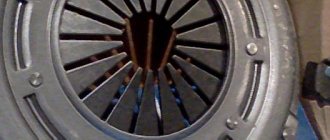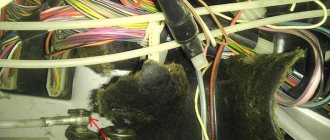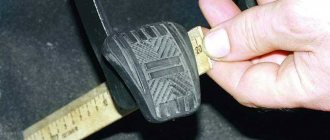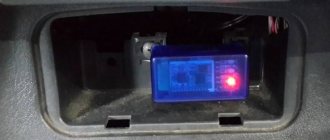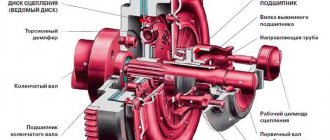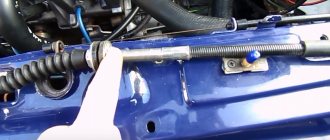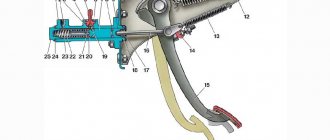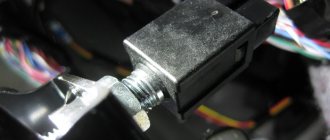VAZ 2109: which clutch to choose and how to do it yourself
Today are no longer the days when the necessary part could only be found from a speculator, purchased at exorbitant prices on the market or through great connections. Then there was more confidence that the quality of the spare part would be 100 percent. Now there are a lot of different clutch kits for the VAZ 2109. “Which clutch to choose?” - this question is becoming more relevant than before. It is noteworthy that on a VAZ 2109 you can determine which clutch is better yourself.
VAZ 2109 when to change the clutch
On the modern market there are copies from different manufacturers, both domestic and foreign, which makes it more difficult to choose truly high-quality clutch discs.
Note! Statistics show that most pressure and driven disks sold in markets and stores are of dubious quality, and sometimes you can even stumble upon counterfeits.
So, which clutch is better to buy and how not to make a mistake in your choice? First you need to figure out what today's manufacturers offer:
- Firstly, this is a factory VIS clutch, also called “stock”. In principle, the product is not bad, it is supplied by the AVTOVAZ plant itself for assembling cars. It is not difficult to distinguish an original clutch from a fake; you just need to check the presence of laser markings applied to the discs themselves. In addition, you can send an SMS with an identification code and receive a response message confirming its uniqueness and quality.
VAZ 2109 clutch kit
- Secondly, there is an imported line of products, this includes VALEO, LUK, SACHS and KRAFT clutches. Among such a variety, the buyer has to make a difficult choice. When choosing, it is not recommended to rely on beautiful packaging and name, since a primitive Chinese counterfeit of a certain brand may be sold.
Single disc clutch diagram
The flywheel is installed on the engine crankshaft. It serves as the clutch drive disc. Modern cars usually use a dual-mass flywheel. This flywheel consists of two parts connected by springs. One part is connected to the crankshaft, the other to the driven disk. The design of the dual-mass flywheel smoothes out jerks and vibrations of the crankshaft. The clutch housing houses the clutch components. The clutch housing is bolted to the engine.
The pressure plate presses the driven disk against the flywheel and, if necessary, relieves it of pressure. The pressure plate is connected to the housing (casing) using tangential leaf springs. Tangential springs, when the clutch is disengaged, act as return springs.
A diaphragm spring acts on the pressure plate, providing the necessary compression force to transmit torque. The diaphragm spring with its outer diameter rests on the edges of the pressure plate. The inner diameter of the spring is represented by elastic metal petals, the ends of which are acted upon by the clutch release bearing. The diaphragm spring is fixed in the housing. Spacer bolts or support rings are used for fastening.
The pressure plate, diaphragm spring and housing form a single structural unit, which bears the established name of the clutch basket. The clutch basket has a rigid bolted connection to the flywheel. Based on the nature of the work, there are two types of clutch baskets - push and pull. In a common push-action clutch basket, the petals of the diaphragm spring move towards the flywheel when the clutch is disengaged. In the clutch exhaust basket it is the other way around - the petals of the diaphragm spring move away from the flywheel. This type of clutch basket is characterized by minimal thickness, therefore it is used in cramped conditions.
The driven disk is located between the flywheel and the pressure plate. The driven disk hub is connected by splines to the input shaft of the gearbox and can move along them. To ensure smooth engagement of the clutch, damper springs are placed in the driven disk hub, acting as a torsional vibration damper.
Friction linings are installed on the driven disk on both sides. The covers are made from glass fibers, copper and brass wires, which are pressed into a mixture of resin and rubber. This composition can withstand temperatures up to 400°C for a short time. The driven disc linings may also have a higher thermal performance. On sports cars they install the so-called. ceramic clutch, the disc linings of which consist of ceramics, Kevlar and carbon fiber. Even more durable metal-ceramic linings that can withstand temperatures up to 600°C.
The clutch release bearing (common name: release bearing) is a transmission device between the clutch and the drive. It is located on the clutch rotation axis and directly acts on the diaphragm spring petals. The bearing is located on the release clutch. The movement of the clutch with the bearing is ensured by the clutch fork.
What to choose
For example, some people prefer a Mercedes, while others prefer a Muscovite. In one case or another, supporters of a particular part, brand or company will find a lot of evidence in their favor. For the above reason, there is no need to compare and draw a conclusion about the best grip. As a rule, this is a matter of habit. Some people prefer a soft clutch, while others have a car with an automatic transmission, where the driver does not even know what the corresponding pedal is for.
VAZ 2109 soft clutch
One way or another, many consumers choose a clutch without taking into account advice and recommendations. They are guided solely by their own experience in operating a particular clutch. Let's look at the most famous brands of car clutch kits; you don't have to follow the recommendations, but it's still worth reading the information. The driver decides which clutch is more suitable: Valio, Kraft or Luk. Sometimes you even have to try all three brands in order to decide on the right part.
French or Korean Valeo
VAZ 2109 clutch drive
It is difficult for high-quality car parts to exist on the Russian market, since many people want to counterfeit them. This also applies to the Valio brand.
Note! A counterfeit of this brand can be immediately tracked by its relatively low cost, as well as by the quality of its constituent elements. Now on the modern market you can find French, Italian, Spanish and South Korean Valio clutch components. From France, of course, less.
Motorists who prefer this brand speak only positively about the products. This clutch is also called female, as it ensures easy and smooth operation.
VAZ 2109 clutch which one to choose
It should also be noted that it has good reliability and a significant service life. If the Valio clutch is used correctly and with care, then it will be enough for 150 thousand kilometers. The original discs are not afraid of overheating (this refers to the permissible limits), while the flywheel is characterized by practical eternity.
German meticulousness of the Luk clutch with high quality
VAZ 2109 clutch which is better
It is difficult to say how plausible the information offered is, but it is still taken into account. They conclude that today such a clutch kit is installed on every second car made in Germany and on every fourth car from another manufacturer. Of course, it is almost impossible to prove this; most likely, it is so. If we take into account the eternal formula of the marketing ratio of price plus quality, then this clutch fits well here.
The best clutch for VAZ 2109
A distinctive feature of the Onion clutch is the vibration damping characteristic of such a device. The corresponding conclusions can be drawn from the reviews of Russian motorists.
Note! Luk clutches are equipped with a special damping element for vibrations of the driven and pressure plate.
Kraft clutch
Best clutch VAZ 2109
Note! The downside, perhaps, is the short service life of the release bearing. As a rule, this will most likely directly depend on the driving style of the vehicle.
Clutch kits from Kraft reliably “sit” in their niche of the Russian car market. And this is not surprising, since the products are characterized by excellent quality despite their low cost. Which clutch to choose for your car will depend only on personal preference. Each of the purchased kits can be installed using a training video and photo completely with your own hands. Also, for ease of work, individual detailed instructions are included. Don't forget that the price should always correspond to the quality.
Motorists magazine
Unfortunately, the use of the power unit (ICE) and gearbox is impossible without using the clutch. One way or another, the car will not be able to adequately respond to driver control, for example, when starting the car, or, worse, while stopping.
How does the clutch work?
Let's look at how the clutch works. Today, a dry, single-disc, constantly engaged clutch has become widespread. That is, it turns out that when the car is parked, or during constant driving (at a certain constant speed), the clutch is always engaged by default and works as a connection between the gearbox (manual or automatic) and the engine flywheel. It turns out that the principle of operation of the clutch is to constantly connect the flywheel of the power unit and the gearbox, and, if necessary, separate them.
Let's continue answering the question of how the clutch works. Let's see what happens when the clutch pedal is fully depressed. When the driver presses the clutch pedal, the force is transmitted through the drive to the release bearing, thus transmitting force to special release springs. And the entire working surface of the clutch is pressed away from the clutch disc. By releasing the disc on the input shaft, the gearbox stops rotation while the power unit continues to operate.
In conclusion, answering the question - how the clutch works, you should tell us what happens when the pedal is not pressed. When the clutch is in the operating positions, the splined coupling receives the input shaft. Under the influence of the release springs on the clutch pressure plate, full contact occurs, in which the flywheel is pressed against the clutch disc. Thanks to this, the torque generated by the engine is completely transmitted via the clutch disc to the gearbox.
- Flywheel;
- The lining of the clutch disc itself.
- Clutch basket pressure surfaces
The principle of operation of the clutch, which is constantly disengaged, is exactly the opposite of that described above. However, this type of clutch is not widely used, and therefore we will not dwell on a more detailed consideration of this issue.
The principle of operation of the clutch is that at certain moments it does not work, while the clutch is constantly engaged and works together with the flywheel and gearbox.
Operating principle of a double-disc clutch
The operating principle of different types of clutches is similar, as is their design. However, they function differently. Let's look at how a double-disc clutch works.
First of all, you should pay attention to the fact that a double-disc clutch is always used on heavily mechanically loaded vehicles. That is, when there is a heavy load on the car’s power unit and a stronger connection between the engine and clutch is needed
Such vehicles can be:
- Armored vehicles;
- Trucks;
- Heavy motorcycles;
- Sports cars.
A double-disc clutch works as follows: with the help of a release bearing, a force is generated that is transmitted to the release levers, which pull back the pressure plate. Then, the pressure disk is disconnected from the first driven disk, and the springs are pressed out. These springs disconnect the intermediate drive disk, which in turn moves away from the second, the friction disk.
Which clutch kits should I choose for VAZ (Lada) 2108/2109?
Last month, PartReview users preferred VALEO. 14% of positive votes belong to this manufacturer.
Luk clutch kits came in second place with 10%.
KRAFT TECH closes the top three with a result of 7% of the votes.
In the general rating of clutch kits, which takes into account the opinions of owners of different brands and models of cars, these brands occupy the following positions:
- VALEO received 8th place, PR score - 73. Data from 121 reviews and 382 votes are taken into account.
- Luk took 5th place, with a PR score of 77. Based on 121 reviews and 201 votes.
- KRAFT TECH - 7th place, and the PR score was 75. Data from 66 reviews and 203 votes are taken into account.
Briefly about the Lada Samara torque transmission system
Before discussing which clutch is better on the VAZ 2114, it would be useful to consider the design features of the friction mechanism. The designers decided to abandon the classic hydraulic drive circuit for controlling the release fork, and developed a mechanical type drive based on a cable for front-wheel drive cars. Constructive nuances can be expressed in the following points:
- A single-disc dry clutch is a permanently closed type device.
- The shutdown process involves a diaphragm pressure spring.
- The driven disk is equipped with a torsional vibration damper.
- Cable clutch drive without gaps between the pressure spring petals and the bearing.
The Samara model is equipped with a clutch with a diameter of 190 mm (2109-1601085), Samara 2 has a clutch with a diameter of 200 mm (2110-1601085). New designs have softer dampers, which makes it possible to effectively smooth out uneven crankshaft rotation not only at idle, but also during load and engine braking. The owner can only determine which clutch is best to install on the VAZ 2114, and choose a high-quality kit from the mass of offers.
Subject to compliance with the operating rules, some copies work out their service life of up to 100-150 thousand km. If previously car owners preferred to buy exactly those clutch parts that had failed, in recent years there has been a change in priorities towards the purchase of kits. This is due to the increasing qualifications of our drivers; many have realized that comprehensive repairs are much more profitable financially.
Tuning VAZ 2109
A car’s clutch, if it is of high quality, can serve without fail for a fairly long period of time, up to 150,000 km. So such a procedure as replacing the clutch may not catch you. But if the car's mileage is over 100,000 km, or there are signs of clutch failure, it's time to think about replacing it. But before you go to the store for a new spare part, it is advisable to decide which clutch is suitable, and what exactly you should pay attention to when choosing this unit. There are many modifications of clutches for VAZs, so you should pay attention to choosing the clutch that is suitable for your car.
Two tables will help you with this:
Driven clutch disc (VAZ)
Clutch pressure plate, or basket (VAZ)
Briefly about the signs of a faulty clutch:
— the clutch slips (the speed increases, but the car does not accelerate); — the clutch does not disengage completely (the clutch is moving); — noises and knocking when the clutch is engaged/disengaged.
If one of the signs of malfunction occurs, a simple clutch adjustment can help, but if that doesn’t help, it’s time to look into choosing a new clutch for your VAZ.
So, what should you pay attention to when choosing a unit such as a clutch?
Driven disk.
The friction surfaces of the friction linings of the driven disk must be homogeneous in composition. It should not be very rough, there should be no cracks, chips, burrs or other similar defects. There should be no oil stains or traces of other liquids on them. These requirements can only be met by a serious manufacturer of spare parts.
Let's pay attention to the rivets of the friction plates and damper plates, they should look the same. There should be no displacement relative to each other and no play of the damper plates and friction linings. Damper springs should also have no play. The splines inside the hub should look neat and free of burrs and cracks.
Often, serious manufacturers put their markings on the damper plate; pay attention to its content and quality of application, this will protect you from purchasing counterfeits.
Pressure disk.
Drive disc - clutch
The driving clutch discs are made of gray cast iron, and the driven discs are made of sheet steel.
The clutch drive disc is secured with a nut at the rear end of the fluid coupling turbine wheel hub. A stamped steel casing is attached to the disk, in which a pressure disk with nine pressure springs and three switching levers is installed. Between the drive disks there is a driven disk with spring linings, mounted on the splines of the gearbox input shaft.
In models released so far with the crankshaft parallel to the axis of the motorcycle, the engine crankshaft and gearbox shafts are also parallel; The clutch drive discs, as is common in cars, are connected to the crankshaft. The engine turns out to be low, but very wide (with horizontal opposing cylinders) and quite long. The generator and distributor are located at the front end of the crankshaft (see Fig. Access to the clutch, gearbox, shift mechanism and kick-starter mechanism is less convenient than with the arrangement shown in Fig.
To connect the flywheel to the clutch, special pins are installed on it or seating belts and threaded holes for fastening bolts are provided, or teeth are cut with which the teeth of the clutch drive disk engage.
| Switching the two-speed PTO drive. |
With an independent PTO drive (Fig. 100, b), the power flow from the engine branches behind the flywheel - one part goes through the driven clutch disk to the transmission, and the other from the driven clutch disk goes to the PTO.
The flywheel, cast from cast iron, serves to remove the pistons from their dead points, carry out auxiliary strokes, uniform rotation of the crankshaft, and also start the engine with a starter, for which a steel ring gear is pressed onto the flywheel rim. In addition, the flywheel is the driving disc of the clutch.
In case of wear, surface cracks, scuffing or warping of the working surfaces, the drive clutch discs are machined and ground until signs of wear are removed.
In order not to disturb the balancing during disassembly, the clutch housing is attached to the flywheel in accordance with the marks. For the ZIM engine, the crankshaft assembly with the fluid coupling (without the clutch drive disc) is subjected to dynamic balancing, with a permissible imbalance of 50 gcm. Before balancing, 6-65 liters of turbine oil are poured into the fluid coupling.
The operation of the clutch is as follows. At the beginning of the shock cycle, the dynamo and brake generators are turned off. The clutch drive disc is closed to the flywheel, and the driven disc is opened. The operator turns on the drive dynamo and spins the clutch flywheel.
The flywheel is cast from cast iron. It serves to remove the pistons from their dead points, carry out auxiliary strokes, uniform rotation of the crankshaft, and also start the engine with a starter, for which a steel ring gear is pressed onto the flywheel rim. In addition, the flywheel serves as the clutch drive disc.
Gray cast iron (GC) is liquid-melting, gives little shrinkage when solidifying, and can be easily processed by cutting. When heated, it retains hardness up to the melting point. It is used for casting cylinder blocks, piston rings, flywheels, clutch drive discs, gearbox housings, etc. Gray cast iron is marked with the letters SCH with a numerical designation indicating the strength of the cast iron.
The ZIM car has a hydraulic coupling installed between the clutch and the engine. The steel clutch body is stamped and welded in two halves and is bolted to the crankshaft flange in place of the flywheel. The coupling body contains impellers, which are hollow stamped rings with welded radial blades located in the bells. The pump wheel is attached to the housing and has 48 blades. The turbine wheel, which has 44 blades, is attached to the hub and connected to the clutch drive plate. The front end of the hub is mounted in a ball bearing fixed in the flange of the clutch housing, and the rear end rests on a roller bearing on the shank of the gearbox input shaft. The front end of this shaft is mounted in the coupling hub on two needle bearings.
Posts 1 to 20 of 163
1 Topic by AlexeyG 2008-12-24 19:42:22 (2009-03-13 11:50:07 edited by maniboo)
- AlexeyG
- User
- Offline
- Registered: 2008-11-09
- Messages: 23
- Reputation: [ 0 | 0 ]
Topic: Clutch selection
It looks like the clutch is about to be replaced, there is a dip in 4th gear, periodically slips in 2nd, sometimes with interference on. transfers. I drive calmly and handle the clutch gently.
I don’t want to buy the factory kit, the reviews are not flattering about it.
A choice arose - to supply a cheaper kit - KRAFTTECH, or Valeo, LUK or SACHS.
I read a lot of reviews on the Internet, some say that the craft is a city, but it doesn’t go much in the region of 10-50 thousand km, some just squeak from it, about Valeo and other reviews are better, but you can easily run into a fake.
As I understand, the main problem with all current clutches is the release clutch.
And somehow 50 thousand is not enough for a clutch, although it is not known how the people who write about it drive.
Who will say what, who changed it, who installed what?
2 Reply from Driver 2008-12-24 19:57:35
- Driver
- User
- Offline
- Registered: 2008-12-08
- Messages: 460
- Reputation: [ 0 | 0 ]
Re: Clutch selection
They say SAX has good grip. Just be careful not to look at a fake. My car now has Kraft. Mostly I drive calmly, but sometimes I let the car go to shit. Once I set it on fire a little when I was dragging the “herring” up the mountain. The engine couldn't handle it and I had to play with the clutch a little. I don’t know how long the old owner drove it. I skated 50 thousand on it and have not yet found any signs of death.
3 Reply from AMX 2008-12-24 20:11:21
- AMX
- User
- Offline
- Registered: 2008-12-11
- Messages: 389
- Reputation: [ 0 | 0 ]
Re: Clutch selection
Craft - woof** +1. A friend put it on drain and it still spits.
Sachs (mine) - Very soft pedal - in traffic jams it’s just super, when compared with the same craft and VIS. But during dynamic driving it smells a little. It cost about 55 thousand. So far it’s normal, I think it’s enough for another 15 safely.
4 Reply from DAF 2008-12-24 20:11:55
- DAF
- User
- Offline
- Registered: 2008-11-19
- Messages: 33
- Reputation: [ 0 | 0 ]
Symptoms of malfunction
The clutch release bearing itself will tell you that its life is already at its limit or it has completely failed. Therefore, your task is to monitor the behavior of the car and promptly respond to emerging problems.
| Sign of breakdown | Peculiarities |
| The clutch pedal becomes hard to press | Initially, this only causes a certain discomfort, since you have to apply more force to change gears. But this phenomenon should not be ignored. Bearing needs to be replaced |
| Difficulty engaging first and reverse gears | This indicates that the bearing's life is gradually ending, and you urgently need to take action. If you don't do this, you will soon be unable to engage any of the gears in your transmission. |
| The car doesn't pull | There is a loss of efficiency and performance of the box. Consequently, it is not possible to change gears correctly and quickly. This makes maneuvers, overtaking and a banal increase in speed more difficult. |
| The car is slipping | This happens occasionally at first, and therefore almost every time you change gears. This symptom clearly indicates that it is time to send the car to a service station or garage for repairs. |
Old and new gearbox
If the release bearing is not replaced in a timely manner, the gearbox will soon fail, the clutch will not work, and this will lead to dire consequences.
Consequences of wear
If you have encountered such a phenomenon as wear of the clutch release bearing, then you probably often drive your own VAZ 2109. It is time and the many kilometers traveled that lead to such breakdowns.
If the bearing is not replaced in time, this will result in the following consequences:
- Any subsequent trip may be the last for the car;
- The clutch disc will overheat, which will lead to destruction of the lining;
- In addition to replacing the bearing, you will have to replace the entire clutch disc;
- It is not uncommon for the clutch to fail. If you hear an incomprehensible noise coming from the clutch system, then there is a problem with it.
Typical breakdowns
The clutch can fail for several reasons:
Diaphragm springs are worn out;
To find the reasons for the failure of the clutch, you will have to disassemble it. But don't be afraid of this process. Even beginners can disassemble and return the unit to functionality if they study the instructions, design, and watch visual videos.
Driven disk of the clutch
Repair work
If you decide to do everything yourself, follow the following sequence of actions.
- Drive onto an overpass or pit. This will make it more convenient for you to work.
- Raise the front of the car using a reliable jack and securely fix the nine.
- Remove the wheels.
- Disconnect the clutch housing ground and clutch cable. Next you will have to remove the transmission.
- To do this, remove the starter by disconnecting the wires, terminals and unscrewing the three mounting nuts.
- Disconnect the speedometer cable and reverse cable.
- Remove the brace fastenings to the suspension arms and move them to the sides.
- Disconnect the ball joints from the swing arms. To do this, you need to remove the cotter pin, unscrew the nut, and knock out the support pin. Then the two nuts are unscrewed and the hinge is disconnected.
- Using a pry bar, press out the tip of the inner CV joint. Be sure to plug the hole formed in the gearbox using improvised means, otherwise oil will begin to pour out of the gearbox.
- Remove the lower clutch housing protection. There are only 3 bolts holding it in place.
- Make supports from bars, bricks for the box and engine.
- Remove the rear supports.
- Unscrew the remaining fasteners and pull the gearbox horizontally. Be careful not to deform the pressure spring lobes with the input shaft.
Removal and inspection
- When unscrewing the mounting bolts, it is better to secure the driven disk with something. A regular large screwdriver will do.
- Be careful not to give out the driven disc and remove the clutch assembly.
- Examine the current condition of the parts. If mechanical damage is noticed on them, we recommend replacing them immediately.
The next step is to check the condition of the parts.
| Object to be checked | Peculiarities |
| Release bearing | Try to crank it up. If crunching or extraneous sounds occur, the part must be replaced. |
| Driven disk | Check it for signs of wear and damage on rubbing surfaces. Also, the rivets should be located at a depth of at least 0.2 millimeters, and the springs in the sockets should only be solid and tightly installed. Otherwise replacement |
| Basket | This is the pressure plate. Check it for damage or cracks on the working surface. Plus the condition of the flywheel is checked |
| Diaphragm spring | If there are cracks here, the petals dangle or are located in different planes, the part goes to scrap, and a new one is installed in its place |
Dismantling work
It is quite rare that individual components of the coupling are changed independently of the others. Mostly repairs involve replacing the assembly, which includes the pressure plate, release bearing and clutch driven disc.
Assembly of the unit is performed in reverse order. Just make sure that you choose really high-quality parts for replacement. For example, a normal quality clutch disc will cost about 1,000 rubles today. We do not recommend taking cheaper options.
Loading …
Signs of malfunctioning parts
The release clutch can fail not only due to improper use, but also due to natural wear and tear. Knowing the operating principle of the device, you can determine its technical condition based on its characteristic symptoms. Typical symptoms of a malfunction are:
- The occurrence of extraneous noise when pressing the clutch pedal. The destruction of the node is accompanied by a grinding or loud crunch.
- Gear shift drive sticking. Sometimes it is impossible to turn on the desired speed.
- Excessively free play of the clutch pedal.
- Incomplete engagement or disengagement of the clutch. The situation may be accompanied by an unpleasant burning smell.
Additional signs of a breakdown are: increased fuel consumption, engine overheating, and jerky movement of the vehicle. The service life of the part is reduced due to dust and dirt getting into the bearing, increased temperature and lack of lubrication.
Signs of a defect cannot be ignored, because... This can lead to serious consequences when driving with a faulty transmission.
Control check
You can diagnose the condition of the squeezing device in the following way:
- Start the car engine. Listen to your work for any extraneous noise. If available, determine the location.
- Depress the clutch pedal. If an extraneous sound appears, the part will need to be replaced.
The bearing cannot be repaired. The problem is solved by replacing the defective part.
Consequences of malfunction
The element has sufficient strength, so it cannot fall apart instantly. However, there is no point in delaying the elimination of the defect, since failure leads to misalignment of the disks and uneven wear. As a result, problems will arise with the transmission, which will negatively affect the technical condition of the vehicle.
